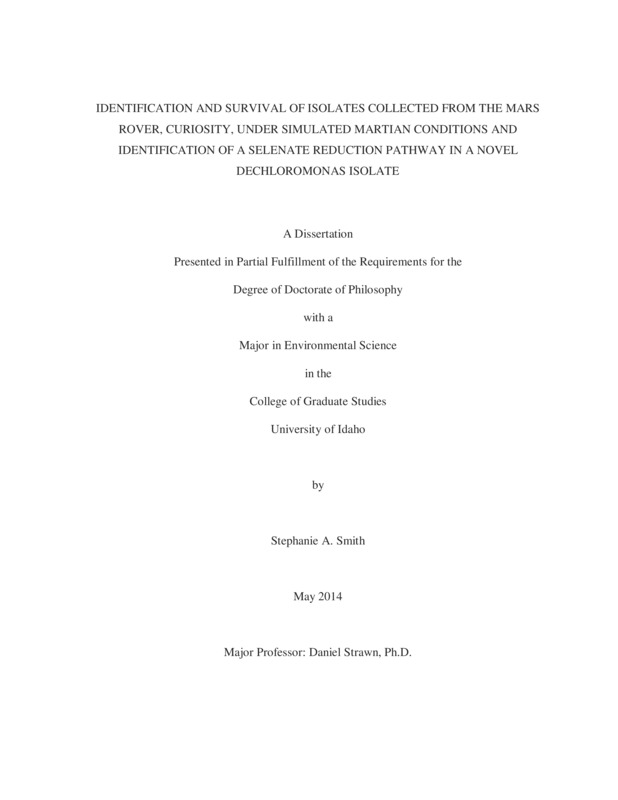IDENTIFICATION AND SURVIVAL OF ISOLATES COLLECTED FROM THE MARS ROVER, CURIOSITY UNDER SIMULATED MARTIAN CONDITIONS AND IDENTIFICATION OF A SELENATE REDUCTION PATHWAY IN A NOVEL DECHLOROMONAS ISOLATE
Smith, Stephanie. (2014). IDENTIFICATION AND SURVIVAL OF ISOLATES COLLECTED FROM THE MARS ROVER, CURIOSITY UNDER SIMULATED MARTIAN CONDITIONS AND IDENTIFICATION OF A SELENATE REDUCTION PATHWAY IN A NOVEL DECHLOROMONAS ISOLATE. Theses and Dissertations Collection, University of Idaho Library Digital Collections. https://www.lib.uidaho.edu/digital/etd/items/smith_idaho_0089e_10253.html
- Title:
- IDENTIFICATION AND SURVIVAL OF ISOLATES COLLECTED FROM THE MARS ROVER, CURIOSITY UNDER SIMULATED MARTIAN CONDITIONS AND IDENTIFICATION OF A SELENATE REDUCTION PATHWAY IN A NOVEL DECHLOROMONAS ISOLATE
- Author:
- Smith, Stephanie
- Date:
- 2014
- Keywords:
- Astrobiology Bioremediation Mars Science Laboratory Planetary protection Selenate reductase Selenium
- Program:
- Environmental Science
- Subject Category:
- Microbiology
- Abstract:
-
The work presented herein is a compilation of two separate research projects. The first project analyzed almost 400 isolates collected from the Mars rover, Curiosity, prior to launch. For the first time in 40 years of Mars spaceflight, we are beginning to understand in-depth the types of culturable microorganisms present on spacecraft and their possible impact on efforts to both detect life and preserve any existing ecosystems on planetary bodies. The research presented here shows that the microorganisms remaining on the spacecraft, after numerous attempts to eradicate them, are very resistant to extreme environmental conditions and are some of the hardiest microorganisms. Most can survive extended periods of desiccation, grow at low temperatures, grow in medium containing elevated salt or pH, and can grow anaerobically utilizing sources known to be available on Mars, such as sulfate, perchlorate, and iron, to conserve energy. Further studies will provide additional insight as to whether these organisms can truly inhabit other worlds, ways to mitigate their initial contamination of spacecraft, and provide additional knowledge as to the limits of life as we know it.
The second study focused on the characterization of a novel dissimilatory selenate reducing organism belonging to the Dechloromonas genus. Several selenate reducing microorganisms have been identified previously but only one microorganism, Thauera selenatis, had been studied in-depth when this study commenced. With a lot of luck, and then an opportunity to perform full-genome sequencing on this Dechloromonas isolate, it was discovered that the selenate reductase pathway is very closely related to the one found in Thauera. There is still much work that needs to be done to have a better understanding of the Se reduction enzymes and their regulatory controls in microorganisms. However, this work is increasing the ability to understand selenium cycling in nature and could lead to the development of bioremediation strategies to be applied in selenium contaminated environments.
- Description:
- doctoral, Ph.D., Environmental Science -- University of Idaho - College of Graduate Studies, 2014
- Major Professor:
- Strawn, Daniel
- Committee:
- Childers, Susan E; Cosens, Barabara; Crawford, Ronald L
- Defense Date:
- 2014
- Identifier:
- Smith_idaho_0089E_10253
- Type:
- Text
- Format Original:
- Format:
- application/pdf
- Rights:
- In Copyright - Educational Use Permitted. For more information, please contact University of Idaho Library Special Collections and Archives Department at libspec@uidaho.edu.
- Standardized Rights:
- http://rightsstatements.org/vocab/InC-EDU/1.0/

